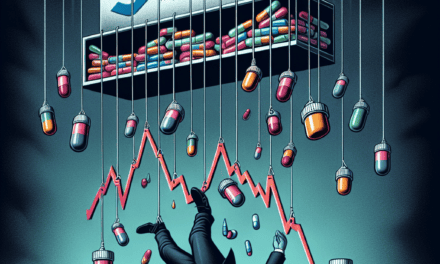“Discover the Secrets Fueling Your Growing Dividends”
Introduction
“Unveiling the Hidden Factors Behind the Dividend Increase” explores the intricate dynamics that drive companies to enhance their dividend payouts. This analysis delves into the strategic decisions and underlying economic conditions that influence such financial maneuvers. By examining corporate earnings, cash flow stability, market conditions, and management strategies, the study aims to uncover the less obvious elements that contribute to dividend growth. Understanding these factors provides investors with deeper insights into a company’s financial health and future prospects, offering a comprehensive view of the motivations and implications behind dividend increases.
Analyzing Market Trends: The Catalyst for Dividend Growth
In recent years, the financial landscape has witnessed a notable trend: the increase in dividend payouts by numerous companies. This phenomenon, while seemingly straightforward, is underpinned by a complex interplay of market trends and economic factors. Understanding these hidden catalysts is crucial for investors seeking to navigate the evolving market dynamics and capitalize on potential opportunities.
To begin with, one of the primary drivers behind the surge in dividend growth is the prevailing low-interest-rate environment. Central banks across the globe have maintained historically low interest rates to stimulate economic growth, making traditional fixed-income investments less attractive. Consequently, investors have turned their attention to dividend-paying stocks as a viable alternative for generating income. This shift in investor preference has prompted companies to enhance their dividend offerings to attract and retain shareholders, thereby fueling the upward trend in dividend payouts.
Moreover, the robust performance of the stock market has played a significant role in facilitating dividend increases. As companies experience growth in their earnings and cash flows, they are better positioned to reward shareholders through higher dividends. This is particularly evident in sectors such as technology and healthcare, where innovation and demand have driven substantial revenue growth. As these companies continue to expand their market share and profitability, they are more inclined to distribute a portion of their earnings to shareholders, further contributing to the rise in dividends.
In addition to these factors, corporate governance practices have evolved to prioritize shareholder returns. Many companies have adopted a more shareholder-friendly approach, recognizing the importance of maintaining investor confidence and loyalty. This shift in corporate strategy has led to a greater emphasis on returning capital to shareholders through dividends and share buybacks. By doing so, companies not only enhance shareholder value but also signal their financial health and stability, which can positively influence their stock prices.
Furthermore, the global economic recovery following the disruptions caused by the COVID-19 pandemic has provided a conducive environment for dividend growth. As economies rebound and consumer demand strengthens, companies are experiencing improved financial performance. This recovery has enabled businesses to rebuild their balance sheets and generate excess cash, which can be allocated towards dividend payments. The resurgence of economic activity has instilled confidence among companies, encouraging them to commit to higher dividend payouts as a reflection of their optimistic outlook.
While these factors have collectively contributed to the increase in dividends, it is essential to acknowledge the potential risks and challenges that could impact this trend. Economic uncertainties, such as inflationary pressures and geopolitical tensions, could pose threats to corporate earnings and cash flows. Companies may need to reassess their dividend policies in response to changing market conditions, which could result in a slowdown or reversal of dividend growth.
In conclusion, the rise in dividend payouts is a multifaceted phenomenon driven by a combination of market trends and economic factors. The low-interest-rate environment, strong stock market performance, evolving corporate governance practices, and global economic recovery have all played pivotal roles in shaping this trend. However, investors must remain vigilant and consider the potential risks that could influence future dividend growth. By understanding these underlying dynamics, investors can make informed decisions and strategically position themselves to benefit from the evolving landscape of dividend-paying stocks.
Corporate Earnings: The Backbone of Dividend Increases
In the realm of corporate finance, dividends serve as a tangible reflection of a company’s financial health and its commitment to returning value to shareholders. While the decision to increase dividends is often celebrated by investors, it is crucial to delve deeper into the underlying factors that drive such decisions. At the heart of these considerations lies corporate earnings, which form the backbone of any sustainable dividend increase. Understanding the intricate relationship between corporate earnings and dividend policies can provide valuable insights into a company’s financial strategy and its future prospects.
To begin with, corporate earnings represent the net income a company generates from its operations after accounting for all expenses, taxes, and costs. These earnings are a fundamental indicator of a company’s profitability and financial stability. When a company experiences robust earnings growth, it is better positioned to reward its shareholders through increased dividends. This is because higher earnings provide the necessary cash flow to support larger dividend payouts without compromising the company’s ability to reinvest in its business or meet its financial obligations.
Moreover, a consistent track record of strong earnings growth can signal to investors that a company is well-managed and capable of sustaining its operations in the long term. This confidence in the company’s financial health often translates into a willingness to increase dividends, as management seeks to share the fruits of its success with shareholders. In this context, a dividend increase can be seen as a vote of confidence in the company’s future earnings potential, reinforcing investor trust and potentially attracting new investors seeking stable income streams.
However, it is important to recognize that not all earnings growth is created equal. Companies must carefully assess the quality and sustainability of their earnings before committing to a dividend increase. For instance, earnings derived from one-time events, such as asset sales or tax benefits, may not be sustainable in the long run. Therefore, companies must ensure that their earnings growth is driven by core business operations and is likely to continue in the future. This prudent approach helps prevent the risk of overextending dividend commitments, which could lead to financial strain if earnings were to decline unexpectedly.
In addition to earnings growth, companies must also consider their payout ratio, which is the proportion of earnings paid out as dividends. A lower payout ratio indicates that a company retains a larger portion of its earnings for reinvestment or to cushion against future uncertainties. Conversely, a higher payout ratio may suggest that a company is prioritizing immediate shareholder returns over long-term growth. Striking the right balance between these two priorities is essential for maintaining a sustainable dividend policy.
Furthermore, external factors such as economic conditions, industry trends, and regulatory changes can also influence a company’s decision to increase dividends. For example, during periods of economic expansion, companies may experience increased demand for their products or services, leading to higher earnings and the potential for dividend increases. Conversely, during economic downturns, companies may adopt a more conservative approach, opting to preserve cash reserves rather than increase dividends.
In conclusion, while dividend increases are often viewed as a positive signal by investors, it is essential to understand the underlying factors that drive these decisions. Corporate earnings play a pivotal role in shaping dividend policies, serving as the foundation upon which sustainable dividend increases are built. By carefully evaluating earnings quality, payout ratios, and external influences, companies can make informed decisions that align with their long-term financial goals and shareholder expectations.
Strategic Acquisitions: Fueling Dividend Expansion
In the realm of corporate finance, dividend increases often serve as a beacon of a company’s financial health and future prospects. While many factors can contribute to a company’s decision to raise dividends, strategic acquisitions stand out as a pivotal element in fueling dividend expansion. These acquisitions, when executed with precision and foresight, can significantly enhance a company’s revenue streams, operational efficiencies, and market position, thereby creating a robust foundation for increased shareholder returns.
To begin with, strategic acquisitions allow companies to diversify their product offerings and enter new markets, which can lead to increased revenue and profitability. By acquiring a company with complementary products or services, a firm can tap into new customer bases and cross-sell its existing products, thereby boosting sales. This expansion not only enhances the company’s market presence but also stabilizes its revenue streams, making it less vulnerable to market fluctuations. Consequently, with a more predictable and diversified income, companies are better positioned to commit to higher dividend payouts.
Moreover, strategic acquisitions often lead to significant cost synergies, which can further bolster a company’s financial performance. By integrating operations, companies can eliminate redundancies, streamline processes, and achieve economies of scale. These cost savings can be substantial, freeing up capital that can be redirected towards rewarding shareholders through increased dividends. Additionally, the enhanced operational efficiency resulting from these synergies can improve profit margins, providing a further impetus for dividend growth.
Furthermore, strategic acquisitions can enhance a company’s competitive advantage, which is crucial for sustaining long-term dividend growth. By acquiring innovative technologies or unique capabilities, a company can strengthen its market position and fend off competition. This competitive edge not only supports sustained revenue growth but also ensures that the company remains a leader in its industry. As a result, the company can maintain a steady trajectory of dividend increases, reflecting its strong market standing and future growth potential.
In addition to these direct financial benefits, strategic acquisitions can also improve a company’s overall risk profile, which is an important consideration for dividend policy. By diversifying its business operations and geographic presence, a company can mitigate risks associated with economic downturns or industry-specific challenges. This risk diversification provides a more stable financial environment, allowing the company to confidently increase dividends without jeopardizing its financial stability.
It is also worth noting that strategic acquisitions can enhance a company’s intangible assets, such as brand reputation and intellectual property, which can have a positive impact on its valuation and, by extension, its dividend policy. A strong brand and valuable intellectual property can drive customer loyalty and command premium pricing, contributing to sustained revenue growth. This intangible value, while not immediately reflected in financial statements, plays a crucial role in supporting long-term dividend expansion.
In conclusion, while the decision to increase dividends is influenced by a myriad of factors, strategic acquisitions emerge as a key driver in this process. By expanding revenue streams, achieving cost synergies, enhancing competitive advantage, improving risk profiles, and bolstering intangible assets, strategic acquisitions provide a solid foundation for companies to increase dividends. As such, investors and stakeholders should closely examine a company’s acquisition strategy when evaluating its potential for dividend growth, recognizing the profound impact these strategic moves can have on shareholder value.
Cost Management: Enhancing Profitability and Dividends

In the realm of corporate finance, the decision to increase dividends is often seen as a reflection of a company’s robust financial health and its commitment to returning value to shareholders. While revenue growth and market expansion are frequently highlighted as primary drivers of dividend increases, an equally critical yet sometimes overlooked factor is cost management. Effective cost management not only enhances profitability but also plays a pivotal role in enabling companies to increase their dividend payouts.
To begin with, cost management involves a strategic approach to controlling and reducing expenses without compromising the quality of products or services. By optimizing operational efficiencies, companies can significantly improve their profit margins. This, in turn, provides the financial flexibility needed to allocate more resources towards dividends. For instance, a company that successfully streamlines its supply chain operations can reduce overhead costs, thereby freeing up capital that can be redirected to shareholders in the form of increased dividends.
Moreover, cost management is not merely about cutting expenses; it is about making informed decisions that align with the company’s long-term strategic goals. By investing in technology and automation, companies can achieve substantial cost savings over time. Automation reduces the reliance on manual labor, minimizes errors, and accelerates production processes, all of which contribute to lower operational costs. These savings can then be channeled into dividend payments, providing a tangible benefit to shareholders.
In addition to operational efficiencies, cost management also encompasses prudent financial management. Companies that maintain a disciplined approach to debt management can reduce interest expenses, thereby improving net income. Lower interest payments mean more cash is available for distribution to shareholders. Furthermore, a strong balance sheet with manageable debt levels enhances a company’s creditworthiness, potentially leading to lower borrowing costs in the future. This financial stability is attractive to investors and can support sustained dividend growth.
Another aspect of cost management that influences dividend increases is the strategic allocation of resources. Companies that prioritize high-return investments and divest from underperforming assets can optimize their capital structure. By reallocating resources to more profitable ventures, companies can generate higher returns on investment, which can subsequently boost earnings and support higher dividend payouts. This strategic focus ensures that every dollar spent contributes to the company’s overall financial health and shareholder value.
Furthermore, effective cost management fosters a culture of accountability and continuous improvement within an organization. By regularly reviewing and analyzing cost structures, companies can identify areas for improvement and implement best practices. This proactive approach not only enhances profitability but also builds a resilient business model capable of weathering economic fluctuations. In times of economic uncertainty, companies with strong cost management practices are better positioned to maintain or even increase dividends, providing a stable income stream for investors.
In conclusion, while revenue growth and market expansion are important factors in determining dividend increases, cost management plays an equally vital role. By optimizing operational efficiencies, managing debt prudently, strategically allocating resources, and fostering a culture of continuous improvement, companies can enhance their profitability and financial stability. These efforts ultimately enable companies to increase their dividend payouts, rewarding shareholders and reinforcing their confidence in the company’s long-term prospects. As such, cost management should be recognized as a fundamental component of a company’s strategy to enhance profitability and deliver sustainable dividends.
Regulatory Changes: Impact on Dividend Policies
In recent years, the landscape of corporate finance has been significantly influenced by regulatory changes, which have, in turn, impacted dividend policies across various industries. Understanding these hidden factors behind dividend increases requires a comprehensive examination of the regulatory environment and its implications for corporate decision-making. As companies navigate this evolving landscape, they must adapt their strategies to align with new regulations, which often results in adjustments to their dividend policies.
One of the primary regulatory changes affecting dividend policies is the implementation of stricter capital requirements. These requirements, often introduced in the wake of financial crises, aim to ensure that companies maintain sufficient capital reserves to withstand economic downturns. As a result, firms are compelled to reassess their capital allocation strategies, balancing the need to retain earnings for future growth with the desire to reward shareholders through dividends. Consequently, companies that successfully navigate these regulatory demands may find themselves in a position to increase dividends, as they demonstrate financial stability and resilience.
Moreover, tax reforms have also played a crucial role in shaping dividend policies. Changes in corporate tax rates and the treatment of dividend income can significantly influence a company’s decision to distribute profits to shareholders. For instance, a reduction in corporate tax rates may lead to increased after-tax profits, providing companies with more flexibility to raise dividends. Similarly, favorable tax treatment of dividend income can make dividends a more attractive option for shareholders, prompting companies to adjust their policies accordingly. Thus, regulatory changes in taxation can create an environment conducive to dividend increases, as firms seek to optimize their financial strategies in response to new tax landscapes.
In addition to capital requirements and tax reforms, regulatory changes in corporate governance have also impacted dividend policies. Enhanced transparency and accountability standards have compelled companies to adopt more shareholder-friendly practices, including the distribution of dividends. As regulatory bodies emphasize the importance of aligning corporate actions with shareholder interests, companies are increasingly motivated to demonstrate their commitment to shareholder value through dividend increases. This shift towards greater corporate responsibility and transparency can lead to more consistent and predictable dividend policies, as firms strive to maintain investor confidence and trust.
Furthermore, regulatory changes in specific industries can have a profound impact on dividend policies. For example, in the financial sector, regulations such as the Dodd-Frank Act in the United States have imposed stringent requirements on banks, affecting their ability to distribute dividends. However, as these institutions adapt to the new regulatory environment and strengthen their financial positions, they may be able to increase dividends, reflecting their improved stability and compliance. Similarly, in the energy sector, regulatory shifts towards sustainable practices and renewable energy sources can influence dividend policies, as companies adjust their strategies to align with environmental standards and investor expectations.
In conclusion, regulatory changes play a pivotal role in shaping dividend policies, influencing corporate decisions through capital requirements, tax reforms, corporate governance standards, and industry-specific regulations. As companies navigate this complex regulatory landscape, they must carefully balance the demands of compliance with the expectations of shareholders. By understanding and adapting to these hidden factors, firms can strategically position themselves to increase dividends, thereby enhancing shareholder value and demonstrating their commitment to financial stability and growth. As the regulatory environment continues to evolve, companies must remain vigilant and proactive in their approach to dividend policies, ensuring that they remain aligned with both regulatory requirements and shareholder interests.
Shareholder Expectations: Driving Dividend Decisions
In the realm of corporate finance, dividend decisions are pivotal, often reflecting a company’s financial health and strategic priorities. Shareholders, as key stakeholders, exert considerable influence over these decisions, with their expectations playing a crucial role in shaping dividend policies. Understanding the hidden factors behind dividend increases requires a nuanced exploration of shareholder expectations and the broader financial landscape.
To begin with, shareholders typically anticipate dividends as a tangible return on their investment, serving as a reward for their trust and financial commitment to the company. This expectation is not merely a passive hope but a driving force that can significantly impact corporate decision-making. Companies, aware of the importance of maintaining shareholder satisfaction, often prioritize dividend payments to signal financial stability and profitability. Consequently, when a company announces a dividend increase, it is often perceived as a positive indicator of its financial health and future prospects.
Moreover, the decision to increase dividends is frequently influenced by the company’s earnings performance. A robust earnings report can bolster shareholder confidence, prompting management to reward investors with higher dividends. This move not only satisfies existing shareholders but also attracts potential investors seeking reliable income streams. However, it is essential to recognize that earnings alone do not dictate dividend increases. Companies must also consider their cash flow situation, ensuring they have sufficient liquidity to support higher payouts without compromising operational needs or growth initiatives.
In addition to financial performance, market conditions play a significant role in shaping shareholder expectations and, by extension, dividend decisions. During periods of economic uncertainty or market volatility, shareholders may prioritize stability and income over capital gains. In such scenarios, companies may opt to increase dividends to reassure investors and mitigate potential sell-offs. Conversely, in a booming market, shareholders might be more inclined to support reinvestment strategies that promise higher long-term returns, potentially leading to more conservative dividend policies.
Furthermore, the competitive landscape within an industry can influence dividend decisions. Companies operating in sectors with high dividend yields may feel compelled to match or exceed their peers’ payouts to remain attractive to investors. This competitive pressure can drive dividend increases, even in the absence of significant earnings growth. However, it is crucial for companies to balance this pressure with their long-term strategic goals, ensuring that dividend policies align with sustainable growth and value creation.
Another hidden factor behind dividend increases is the tax environment. Changes in tax legislation can alter the attractiveness of dividends relative to other forms of shareholder returns, such as share buybacks. For instance, if dividend tax rates are reduced, companies might be more inclined to increase dividends, as shareholders would retain a larger portion of their payouts. Conversely, higher dividend taxes could prompt companies to explore alternative methods of returning value to shareholders.
In conclusion, while shareholder expectations are a driving force behind dividend decisions, they are intertwined with a myriad of factors, including financial performance, market conditions, competitive dynamics, and tax considerations. Companies must navigate these complexities to craft dividend policies that not only meet shareholder expectations but also support long-term strategic objectives. By understanding the hidden factors behind dividend increases, investors can gain valuable insights into a company’s financial health and strategic direction, ultimately guiding their investment decisions.
Economic Indicators: Predicting Future Dividend Trends
In the realm of financial markets, dividends serve as a crucial indicator of a company’s financial health and its commitment to returning value to shareholders. Understanding the factors that lead to a dividend increase can provide investors with valuable insights into future trends and potential investment opportunities. While many investors focus on a company’s earnings and cash flow as primary indicators, there are several hidden factors that can significantly influence a company’s decision to raise its dividends.
To begin with, macroeconomic conditions play a pivotal role in shaping dividend policies. During periods of economic expansion, companies often experience increased revenues and profitability, providing them with the financial flexibility to enhance shareholder returns through higher dividends. Conversely, in times of economic downturn, companies may opt to conserve cash, leading to stagnant or reduced dividend payouts. Therefore, monitoring economic indicators such as GDP growth, unemployment rates, and consumer confidence can offer clues about the likelihood of future dividend increases.
In addition to macroeconomic factors, industry-specific trends can also impact dividend decisions. For instance, companies operating in sectors with stable and predictable cash flows, such as utilities or consumer staples, are more likely to maintain or increase dividends even during economic uncertainty. On the other hand, industries characterized by high volatility and capital-intensive operations, like technology or energy, may exhibit more erratic dividend patterns. Thus, understanding the dynamics of the industry in which a company operates can provide further context for predicting dividend trends.
Moreover, a company’s capital allocation strategy is another critical determinant of its dividend policy. Firms with a strong commitment to returning capital to shareholders often prioritize dividends as a key component of their capital allocation framework. This commitment is typically reflected in a company’s dividend payout ratio, which indicates the proportion of earnings distributed as dividends. A consistently high payout ratio may signal a company’s confidence in its future earnings potential and its willingness to reward shareholders. However, it is essential to consider the sustainability of such a strategy, as excessively high payout ratios may not be sustainable in the long term.
Furthermore, corporate governance practices can influence dividend decisions. Companies with a shareholder-friendly governance structure are more likely to prioritize dividend payments as a means of aligning management’s interests with those of shareholders. This alignment often results in a more transparent and predictable dividend policy, which can be particularly appealing to income-focused investors. Additionally, the presence of activist investors or significant institutional ownership can exert pressure on management to increase dividends, thereby enhancing shareholder value.
Lastly, regulatory and tax considerations can also impact dividend policies. Changes in tax legislation, such as alterations in dividend tax rates, can influence a company’s decision to adjust its dividend payouts. Similarly, regulatory requirements or restrictions in certain industries may affect a company’s ability to distribute dividends. Therefore, staying informed about the regulatory environment and potential tax implications is crucial for anticipating changes in dividend trends.
In conclusion, while earnings and cash flow remain fundamental to understanding dividend increases, a comprehensive analysis requires considering a multitude of hidden factors. By examining macroeconomic conditions, industry-specific trends, capital allocation strategies, corporate governance practices, and regulatory considerations, investors can gain a more nuanced understanding of the forces driving dividend decisions. This holistic approach not only aids in predicting future dividend trends but also empowers investors to make more informed investment choices.
Q&A
1. **What are the primary reasons companies increase dividends?**
Companies often increase dividends due to strong financial performance, excess cash reserves, a desire to attract or retain investors, and confidence in future earnings growth.
2. **How does a company’s earnings growth impact its dividend policy?**
Sustained earnings growth provides the financial flexibility to increase dividends, as it indicates a stable or improving financial position and the ability to generate consistent cash flow.
3. **What role does cash flow play in dividend increases?**
Healthy and stable cash flow is crucial for supporting dividend increases, as it ensures the company can meet its dividend obligations without compromising operational needs.
4. **How do market conditions influence dividend decisions?**
Favorable market conditions, such as economic growth and low interest rates, can encourage companies to increase dividends as a signal of financial strength and stability.
5. **Why might a company choose to increase dividends instead of reinvesting in the business?**
A company might prioritize dividend increases over reinvestment to reward shareholders, especially if it believes that the return on reinvestment opportunities is lower than the value provided to shareholders through dividends.
6. **What is the impact of a strong balance sheet on dividend increases?**
A strong balance sheet, characterized by low debt levels and high liquidity, provides the financial security needed to support dividend increases without jeopardizing the company’s financial health.
7. **How do shareholder expectations affect dividend policies?**
Shareholder expectations can pressure companies to increase dividends, especially if investors view dividends as a key component of their investment return and a sign of company stability.
Conclusion
The conclusion of “Unveiling the Hidden Factors Behind the Dividend Increase” highlights that the decision to raise dividends is influenced by a complex interplay of factors beyond mere profitability. Key determinants include a company’s strategic financial management, such as optimizing capital structure and maintaining a healthy cash flow. Additionally, market conditions, investor expectations, and regulatory environments play crucial roles. The analysis underscores the importance of understanding these hidden factors to accurately assess a company’s financial health and future growth potential, ultimately aiding investors in making informed decisions.





